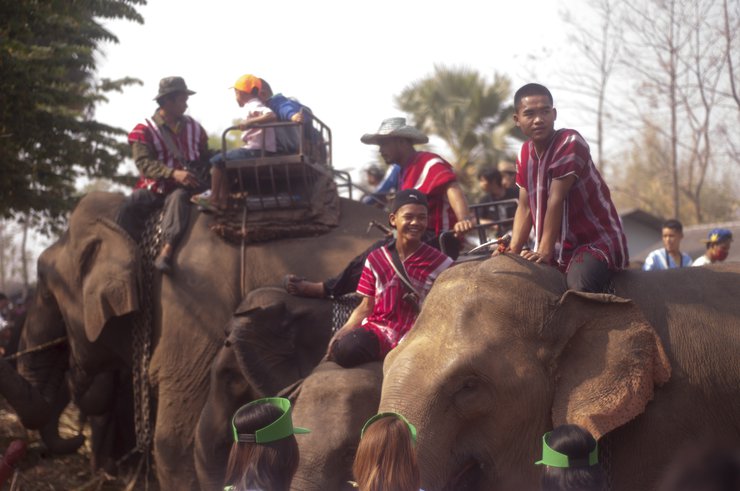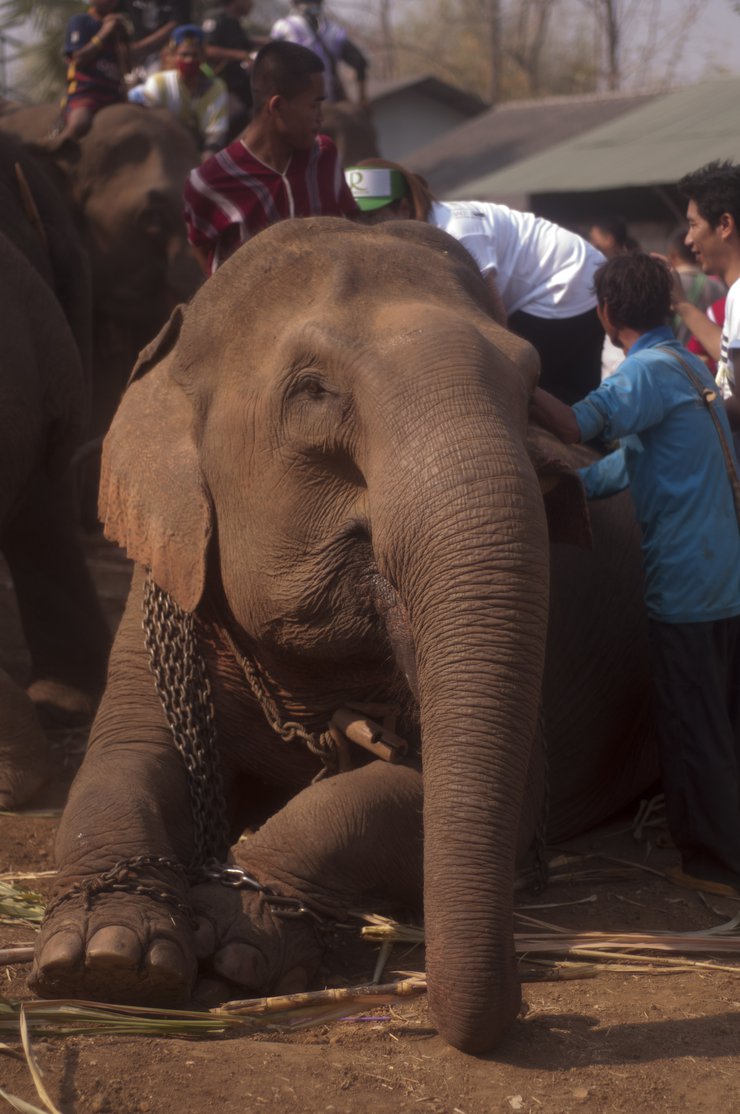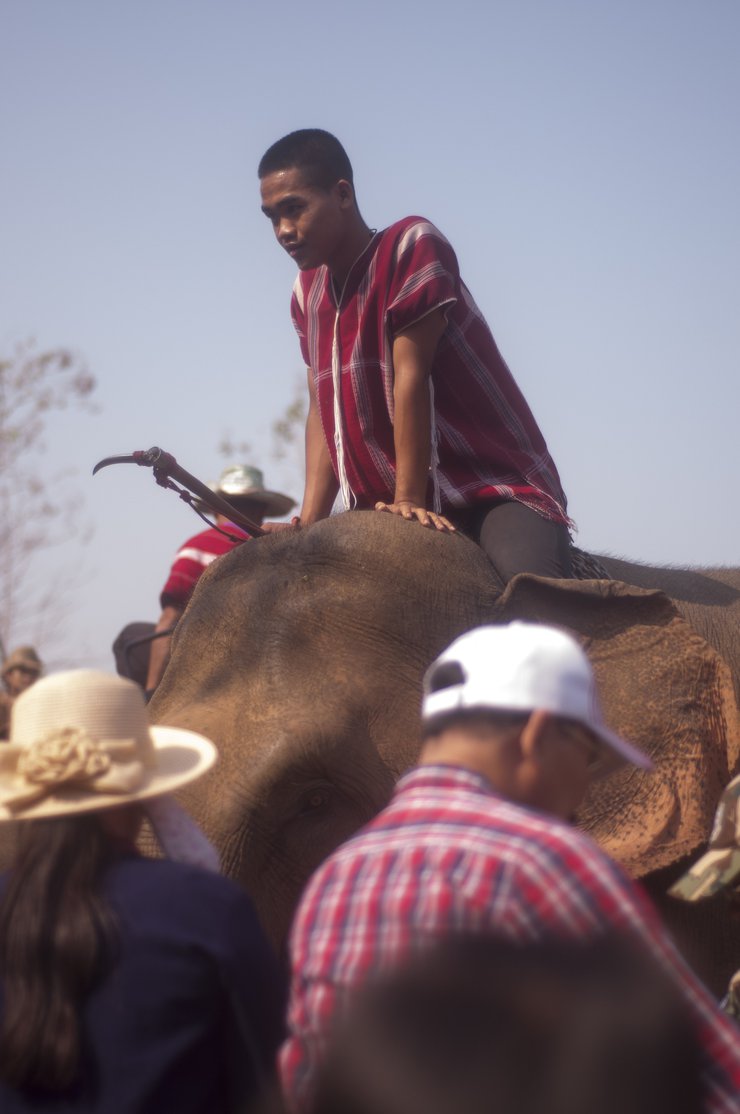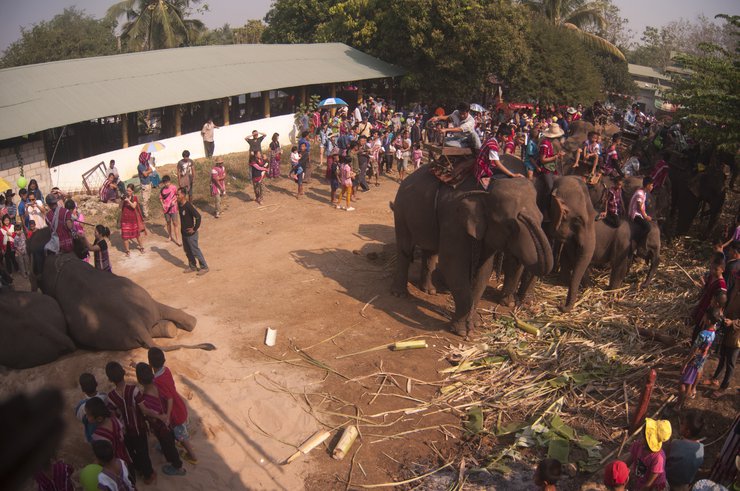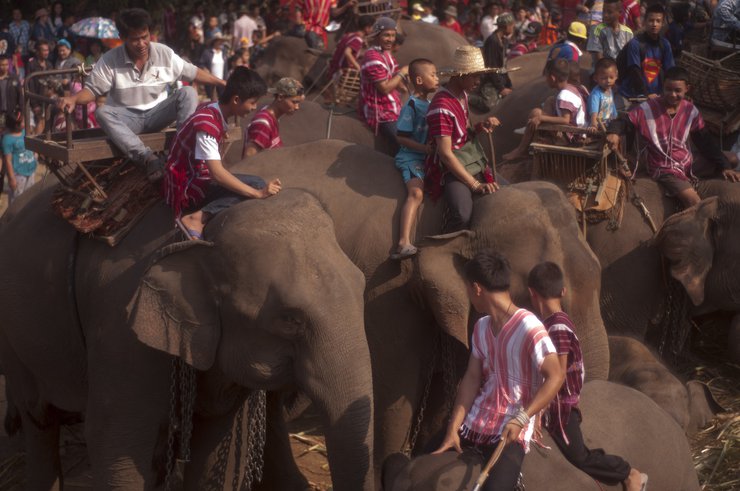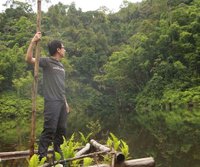
This trip starts with this picture. A group of young Karen elephant handlers with PR girls from Robinson Maesod at the Thai Elephant Festival.
March 13th, early last year.

A young girl from the Karen ethnic group, dressed in bright colors, takes a picture with a large elephant at the Thai Elephant Day event in Ban Poo Teur.
This is a repeat of a previous visit to the Thai Elephant Day event in Ban Poo Teur, Mae Ku Subdistrict, Mae Sot District, Tak Province.
March 13th of every year is Thai Elephant Day.
.
Ban Poo Teur is a village of the Karenni or Bakla Karen people, and is an elephant-raising village that is over 200 years old.
To get there, travel south from Mae Sot for about 17 kilometers and you will find the entrance gate. The gate is shaped like an elephant, and the entrance is a concrete road that is easy to access.
.
Every year, the Mae Ku Subdistrict Administrative Organization (SAO) organizes a Thai Elephant Day event, along with other locations throughout the country.

The mahout instructed the elephant to kneel so that the young PR Robinson Mae Sot students could mount its back.

The young Karen men here are exceptionally skilled elephant handlers, unmatched in their expertise.
As the elephants marched towards the ceremonial pavilion, I felt as if I had been transported back to ancient times.


When the elephant handlers led the elephants into the ceremony ground, all the visiting guests had the opportunity to ride on the elephants' backs or sit on the gub, which is called "gla" in the Karen language.

A legend of the Pga K'nyau people tells the story of the elephant.
It is said that...
Before elephants were elephants as they are today, they were once humans. They even owned thousands of acres of rice fields. However, they later broke the village rules by drinking water from the source in the middle of the forest. This caused their noses to grow long, and they were eventually driven out of the village.
Therefore, in the Pga K'nyau people's belief, elephants are people.

The Elephant and the Mahout Smile
This phrase evokes a heartwarming image of a harmonious relationship between an elephant and its mahout. The shared smile suggests a deep bond of trust and affection, built through years of shared experiences and mutual understanding.
Here's a breakdown of the translation:
- ช้าง (Chang): Elephant
- และ (Lae): And
- ควาญ (Khwan): Mahout (elephant caretaker)
- ยิ้ม (Yim): Smile
The simple act of smiling speaks volumes about the connection between these two beings. It implies a sense of contentment, happiness, and mutual respect. The image is one of peaceful coexistence and collaboration, highlighting the unique bond that can exist between humans and animals.

The origin of Ban Poo Teur is said to be
The first person to settle in the village was named Poo Teur, hence the current name of the village.
Poo Teur was an elephant keeper. He used elephants to make a living, such as farming, plowing, building houses, and hauling. Imagine that in the past, there were no cars or electricity, so elephants had to be used to help people survive.
Because Poo Teur raised many elephants, the elephants became an inheritance passed down to his descendants from generation to generation until today.
Ban Poo Teur, Poso, has become a village of elephant keepers, another important tourist destination.
Next time, I will review the food and accommodation in the village.
00000

Top image: Tourists riding on the backs of young elephants, a popular activity for families visiting the park. Bottom image: A herd of elephants, including young calves, protected by their mothers and the herd leader.

00000
For the Karen people, elephants are not just working animals.
The Karen believe that elephants are an inheritance for their sons to make a living, while the land will be kept for their daughters.
.
.
.

.
The belief that families who raise elephants cannot commit adultery is not supported by evidence. For example, if adultery occurs, the elephant may fall ill.
(Note: This is a translation of the provided text, not the original text itself.)
(This is a story that happened last year. Please use discretion.)

In the picture, the mahout leads the elephant to bathe in the prepared water, as the weather in March is quite hot.
.
.

The little elephant and mahout are both cool and refreshed.
.
.

Our mahouts are enjoying ice cream to cool down before leading the elephants to their next feast: a Chinese banquet.

This Chinese banquet table features a variety of fruits, including sugarcane, bananas, watermelon, cantaloupe, palm heart, and pomelo, as well as a diverse selection of vegetables.
The highlight is sugarcane, which elephants love.

Photographers, journalists, and tourists from various backgrounds flocked to the Ban Pu Toei Elephant Festival.
.
.

It is fascinating that the Karen people of Ban Poo Tiao have been raising elephants for over 200 years, passing down the tradition through generations and across diverse groups. Today, the number of elephants in Ban Poo Tiao has dwindled significantly (the exact number is still being determined and will be updated). Due to environmental issues and deforestation, many elephants have been sold to various elephant camps.
The Karen people of Ban Poo Tiao do not view elephant raising as a tourism business, as they consider elephants to be members of their families.
The Karen people of Ban Poo Tiao warmly welcome all visitors with deep understanding.
00000

00000
300859
00000
300859
ginnagan
Friday, September 27, 2024 10:24 AM




